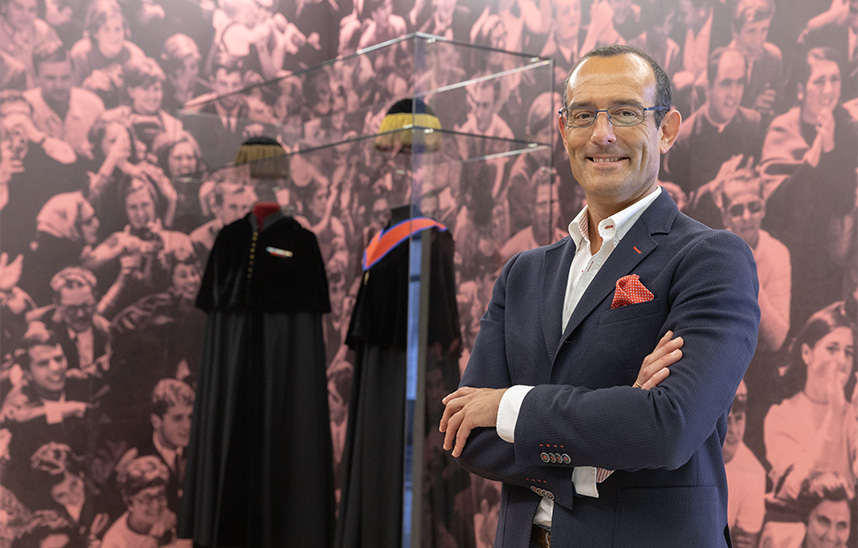A thesis of the University collects and analyzes 276 works of art kept at the academic center.
At research, 2,200 pictorial, sculptural, gold and silver works and first class furnishings from pre-Columbian times to the present have been inventoried.

FotoManuelCastells/El researcher and coordinator general of the association de Amigos de la Universidad de Navarra, Manuel Vilches, next to the academic costumes exhibited in the hall of Office of the Executive Council.
A doctoral thesis defended last June 28 at the School of Philosophy and Letters of the University has catalogued and analyzed 276 pictorial works preserved in the academic center. The research has been carried out by Manuel Vilches, coordinator general of the association of Friends of the University of Navarra, and directed by Asunción Domeño, Assistant Professor of Art History, and Javier Azanza, Full Professor of Art History.
The doctor has inventoried more than 4000 pieces, after visiting 37 buildings of the campus of Pamplona, San Sebastian, Barcelona and Madrid during a year and a half. Of these, nearly 2,200 have been classified as works of art. For the thesis , a selection of 276 paintings has been made. "Within this group there are some belonging to artists such as Pablo de Céspedes, Francisco Pacheco, Giovanni Francesco Barbieri, Il Guercino, Pedro Atanasio de Bocanegra, or Joseph de la Cruz". Among the most significant works, stands out The Immaculate Conception by Francisco Pacheco, an oil painting that presides over the chapel of Central Building: "It is the first one painted by the author, in which his daughter served as model , who later became Velázquez's wife, and which will set the instructions of the model immaculista for all the painters that will come later, such as Velázquez himself, Ribera, Zurbarán, etc.".
During the research , other pieces of sculpture, goldsmithing and furniture of the highest level, ranging from pre-Columbian art to the present day, were also catalogued. As part of the process, the author collected in the field data on the location, measurements, and state of conservation of each piece, searched for marks or signatures, and photographed them, eventually taking more than 15,000 images. He acknowledges that during the development of the work there were some significant challenges, such as "the order, method and discipline required to make the inventory so as not to leave anything unrecorded", or the definition of the index of the thesis , which at first sought to cover a wide range of pieces, with a sample of the different arts, but which finally had to be narrowed down to a selection of paintings. "Even so, the thesis is over 1000 pages long."
According to the author, this work opens up new ways to make the University's cultural heritage known. His proposals include the adaptation of the thesis into a book for knowledge dissemination, the creation of a specific section on the University's website, the organization of temporary exhibitions, the loan of works to museums and institutions, or the study of some of the pieces in Art-related subjects taught in different degrees. "The detailed knowledge of this heritage is crucial. We have the responsibility to preserve this bequest and transmit it to future generations and the University has a great human and professional potential capable of carrying it out in an interdisciplinary way."
